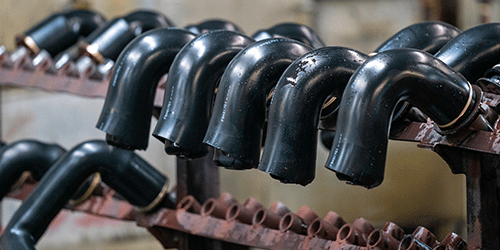Sponge rubber is a very versatile material and one that Sperry & Rice has a great deal of experience formulating and extruding. This post is meant to explain more about sponge rubber, its benefits, different varieties, applications, and industries it is used in.
Sponge rubber can be formulated as open cell or closed cell, but it is more commonly used in closed cell formulations. The “cells” inside the sponge rubber are like bubbles in foam or cake batter, and they do not connect with one another so closed cell walls prevent liquids and gasses from passing through the rubber. As such, closed cell sponge rubber can be formulated to make it suitable for virtually any application.
The benefits of sponge rubber:
Sponge rubber can be customized by profile and be laminated with adhesive. Other advantages include its:
Sponge rubber types:
Chloroprene / neoprene sponge rubber (CR)
Neoprene is a synthetic rubber that is a very widely used closed cell sponge. It can be used in both hot and cold environments because it has excellent chemical, solvent, and oil stability.
Neoprene is flame retardant and is resistant to degradation. It is common in the automotive industry because it is durable, flexible, and recovers well under compression.
EPDM sponge rubber
EPDM sponge has excellent ultraviolet, temperature, ozone, and weathering resistance as well as resistance to oils, gasoline, and acids. Its uses include heat seals, HVAC and refrigerator seals, and gaskets.
Nitrile sponge rubber
Nitrile sponge is a soft and flexible rubber with excellent thermal properties, making it ideal for insulating hot and cold pipes. Nitrile sponge rubber only requires slight pressure to form a durable seal, which makes it perfect for gaskets and washers. It’s oil and chemical resistant too.
Applications ofsponge rubber:
Some of the most common applications for sponge rubber are for sealing outdoor enclosures, gaskets that provide shock absorption, and vibration limiting cushions. Sponge rubber is widely used in the automotive, transportation, construction, and HVAC industries.
Sponge rubber is also a very good insulation material.
Industry usage of sponge rubber:
The automotive industry uses sponge rubber in:
The appliance industry uses sponge rubber in:
The transportation industry uses sponge rubber in:
The HVAC industry uses sponge rubber in:
Sponge rubber is incredibly versatile and can be formulated to create a virtually unlimited number of components for any industry.
Sperry & Rice has expert knowledge of sponge rubber formulations and applications and offers innovative engineering, advanced manufacturing processes, and comprehensive quality controls to produce precision extruded synthetic rubber components for the HVAC, automotive, transportation, and appliance industries. Our reputation lies in making sure that the rubber we provide makes the finished products of our clients reliable, and of the highest quality.
For more information about sponge rubber engineering, contact us!
